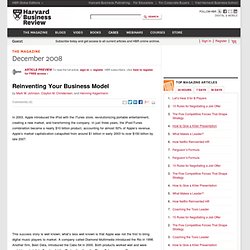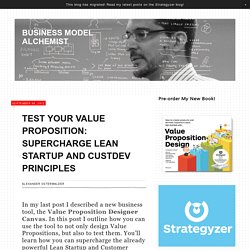

Www.iese.edu/research/pdfs/di-0862-e.pdf. Www.softwarepublico.gov.br/5cqualibr/6-publicacoes-e-artigos/view/vetor-ecossistema/sobre-modelo-de-neg-cios/Claryfing-Busines-Model.pdf. Startupms.com.br/wp-content/uploads/2012/04/Running.Lean_.pdf. Www.4sprogram.org/uploads/9/2/6/9/9269938/lean_canvas_business_model_guide.pdf. Wp-content/uploads/LeanCanvas.pdf. Www.ondernemenzondergrenzen.nl/uploaded_files/6_reinventing_your_business_model.pdf. How to Identify New Business Models. How to Design a Winning Business Model. The Idea in Brief There has never been as much interest in business models as there is today; seven out of 10 companies are trying to create innovative business models, and 98% are modifying existing ones, according to a recent survey.

However, most companies still create and evaluate business models in isolation, without considering the implications of how they will interact with rivals’ business models. This narrow view dooms many to failure. Moreover, companies often don’t realize that business models can be designed so that they generate virtuous cycles—similar to the powerful effects high-tech firms such as Facebook, eBay, and Microsoft enjoy. These cycles, when aligned with company goals, reinforce competitive advantage. By making the right choices, companies can strengthen their business models’ virtuous cycles, weaken those of rivals, and even use the cycles to turn competitors into complementary players.
That isn’t surprising. “Isn’t that strategy?” Reinventing Your Business Model. In 2003, Apple introduced the iPod with the iTunes store, revolutionizing portable entertainment, creating a new market, and transforming the company.

In just three years, the iPod/iTunes combination became a nearly $10 billion product, accounting for almost 50% of Apple’s revenue. Apple’s market capitalization catapulted from around $1 billion in early 2003 to over $150 billion by late 2007. This success story is well known; what’s less well known is that Apple was not the first to bring digital music players to market.
A company called Diamond Multimedia introduced the Rio in 1998. Another firm, Best Data, introduced the Cabo 64 in 2000. Understanding the key variables in Viral Marketing. A short study of this web site reveals that a hugely important factor for success in startup companies is finding ways to acquire customers at a low cost.

In the Business Models section, we looked at the perfect business model: Viral customer acquisition with good monetization. However viral growth turns out to be an elusive goal, and only a very small number of companies actually achieve true viral growth. In 2005, I invested in a company called Tabblo (acquired by HP in 2007), and had the good fortune to work with an outstanding entrepreneur, Antonio Rodriguez. Tabblo did manage to achieve good viral growth, but around the same time YouTube was launched and managed to achieve explosive viral growth. In the process of looking at these two companies, we learnt several important things about virality. To give you a preview of this post, what you will learn is that there are two key parameters that drive how viral growth happens, the Viral Coefficient, and the Viral Cycle Time.
Business Model Analysis, Part 1: Key Questions. Student.bus.olemiss.edu/files/conlon/Others/Others/__BookChapter_SocialMEsia_EBusiness/An e-Business Model Ontology for Modeling e-Business.pdf. Test Your Value Proposition: Supercharge Lean Startup and CustDev Principles. In my last post I described a new business tool, the Value Proposition Designer Canvas.

In this post I outline how you can use the tool to not only design Value Propositions, but also to test them. You’ll learn how you can supercharge the already powerful Lean Startup and Customer Development principles to design, test, and build stuff that customers really want. The Value Proposition Designer Canvas (VP Designer Canvas) allows you to zoom into the details of your Value Proposition and the Customer Segments you target. You can use it as a poster (cf image below) to design better Value Propositions with sticky notes. However, to make sure your customers really want what you design, you'll need to test all the assumptions you make with the VP Designer Canvas.
We already now know how to do this kind of designing and testing for business models: by combining the Business Model Canvas with the Customer Development process. Supercharge the Lean Startup Process. Business models.